Click image for BBB rating
See our Privacy Policy
cool="cool" width="785" height="6370" border="0" cellpadding="0" cellspacing="0" gridx="16" showgridx="showgridx" usegridx="usegridx" gridy="16" showgridy="showgridy" usegridy="usegridy" bgcolor="#99ccff">
|
|
|
 |
|
|
|
|
|
|
Spaightwood Galleries, Inc.
To purchase, call us at 1-800-809-3343 (1-508-529-2511 in Upton MA & vicinity) or send an email to spaightwood@gmail.com.
We accept AmericanExpress, DiscoverCard, MasterCard, and Visa.
We also accept wire transfers and paypal.
For directions and visiting information, please call. We are, of course, always available over the web and by telephone (see above for contact information). Click the following for links to past shows and artists. For a visual tour of the gallery, please click here. For information about Andy Weiner and Sonja Hansard-Weiner, please click here. For a list of special offers currently available, see Specials.
All works are sold with an unconditional guarantee of authenticity (as described in our website listing).
Go back to the top of this page.
Visiting hours: Saturday 10:00 am to 5:00 pm and Sunday noon to 6:00 pm and other times by arrangement.
Please call to confirm your visit. Browsers and guests are welcome.
|
|
|
|
|
The story of Joseph, the youngest son of Jacob / Israel is told in Genesis. It is a story whose theme is that God can supply happy endings to bad beginnings, that life under God is essentially comic, not tragic. Joseph's father Israel loves Jospeh best because he is the child of his old age and his brothers hate him in consequence: "And Joseph dreamed a dream, and he told it his brethren: and they hated him yet the more. And he said unto them, Hear, I pray you, this dream which I have dreamed: For, behold, we were binding sheaves in the field, and, lo, my sheaf arose, and also stood upright; and, behold, your sheaves stood round about, and made obeisance to my sheaf. And his brethren said to him, Shalt thou indeed reign over us? or shalt thou indeed have dominion over us? And they hated him yet the more for his dreams, and for his words. And he dreamed yet another dream, and told it his brethren, and said, Behold, I have dreamed a dream more; and, behold, the sun and the moon and the eleven stars made obeisance to me. And he told it to his father, and to his brethren: and his father rebuked him, and said unto him, What is this dream that thou hast dreamed? Shall I and thy mother and thy brethren indeed come to bow down ourselves to thee to the earth? And his brethren envied him; but his father observed the saying" (Genesis 37:5-37:11).
|
|
|
|
|
|
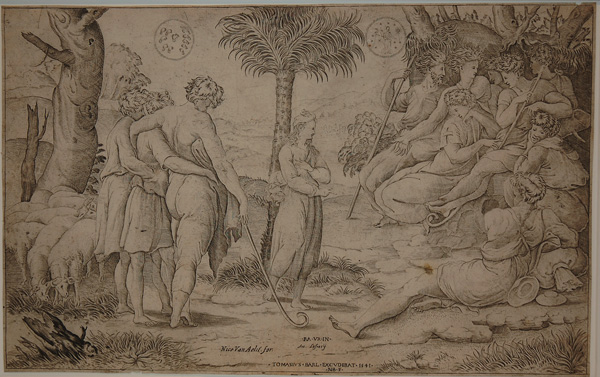 |
|
|
|
Nicolas Beatrizet (Italian, c. 1515-1560), Joseph explaining his dreams to his brothers (The Illustrated Bartsch 29.009.iii/iii; it is a reverse copy of TIB 29.005 rather than taken directly from Raphael's painting). Engraving after an engraving after Raphael's painting in the Vatican Loggia, 1541. A good impression in brown ink on laid paper trimmed on or within the platemark; two small paper losses bottom left and upper right, both outside the border, and a small stain on the left thigh of the brother reclining bottom right. Inscribed: ".RA.VR.IN. / .TOMASIVS.BARL.EXCVDEBAT.1541. / .NB.F." bottom center. "Ant. Lafrery" is added in Italic underneath the credit to Raphael of Urbino; "Nico.Van Aelst. for" is added below and to the left of the credit to Lafrery. Originally published Tomaius Barlacchi (who was active in the 1540s and published other engravings after Raphael during this period), then by Lafrery, who was active during the 1560s and early 1570s, the plate was acquired by Nicola van Aelst after 1577. Van Aelst died in 1613, so our impression was printed sometime between 1577 and 1613. Image size: 230x371mm. Price: Please call or email for current pricing information.
|
|
|
|
|
|
When Israel sends Joseph out to see how his brothers are doing tending the flocks, they see Joseph coming and decide to kill him. Reuben tries to save his life by suggesting that they simply dump him in a cistern and leave him there, but after he leaves, they take advantage of the opportune arrival of a caravan headed for Egypt and sell him to them: "And when they saw him afar off, even before he came near unto them, they conspired against him to slay him. And they said one to another, Behold, this dreamer cometh. Come now therefore, and let us slay him, and cast him into some pit, and we will say, Some evil beast hath devoured him: and we shall see what will become of his dreams. And Reuben heard it, and he delivered him out of their hands; and said, Let us not kill him. And Reuben said unto them, Shed no blood, but cast him into this pit that is in the wilderness, and lay no hand upon him; that he might rid him out of their hands, to deliver him to his father again. And it came to pass, when Joseph was come unto his brethren, that they stripped Joseph out of his coat, his coat of many colours that was on him; And they took him, and cast him into a pit: and the pit was empty, there was no water in it. And they sat down to eat bread: and they lifted up their eyes and looked, and, behold, a company of Ishmeelites came from Gilead with their camels bearing spicery and balm and myrrh, going to carry it down to Egypt. And Judah said unto his brethren, What profit is it if we slay our brother, and conceal his blood? Come, and let us sell him to the Ishmeelites, and let not our hand be upon him; for he is our brother and our flesh. And his brethren were content. Then there passed by Midianites merchantmen; and they drew and lifted up Joseph out of the pit, and sold Joseph to the Ishmeelites for twenty pieces of silver: and they brought Joseph into Egypt. And Reuben returned unto the pit; and, behold, Joseph was not in the pit; and he rent his clothes. And he returned unto his brethren, and said, The child is not; and I, whither shall I go? And they took Joseph’s coat, and killed a kid of the goats, and dipped the coat in the blood; And they sent the coat of many colours, and they brought it to their father; and said, This have we found: know now whether it be thy son’s coat or no. And he knew it, and said, It is my son’s coat; an evil beast hath devoured him; Joseph is without doubt rent in pieces. And Jacob rent his clothes, and put sackcloth upon his loins, and mourned for his son many days. And all his sons and all his daughters rose up to comfort him; but he refused to be comforted; and he said, For I will go down into the grave unto my son mourning. Thus his father wept for him. And the Midianites sold him into Egypt unto Potiphar, an officer of Pharaoh’s, and captain of the guard" (Genesis 37:18-36).
|
|
|
|
|
|
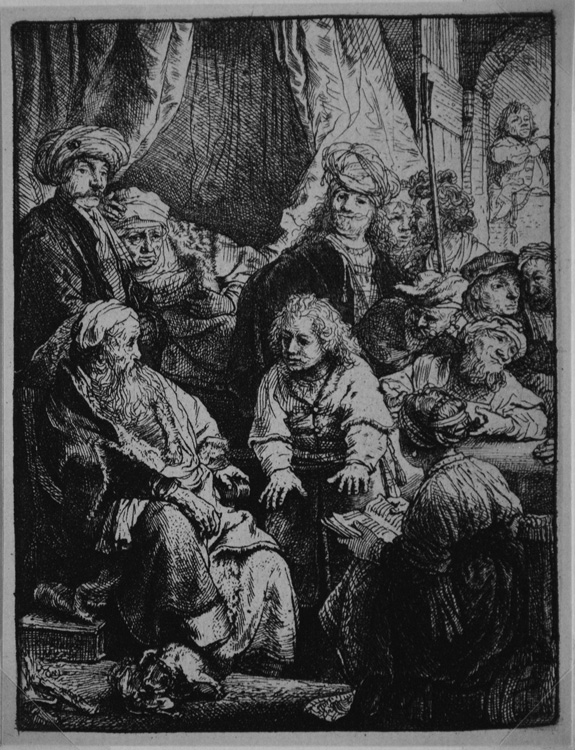 |
|
Joseph telling his dreams to his father and brothers (Bartsch 37, Boon 139). Original etching on laid paper with small margins, 1638. A very good impression with plate tone printed on laid paper with thread margins outside the platemark. Signed and dated "Rembrandt f. 1638" in the plate on the base of Isaac's chair. Joesph's father Isaac recoils and his brothers all clump together anticipating their decsion, soon following, to kill Joseph, quickly modified into selling him into slavery to merchants heading to Egypt. Our impression is from an early Basan printing. Image size: 110x83mm. Price: Please call or email for current pricing information.
|
|
|
|
|
|
|
|
|
|
|
|
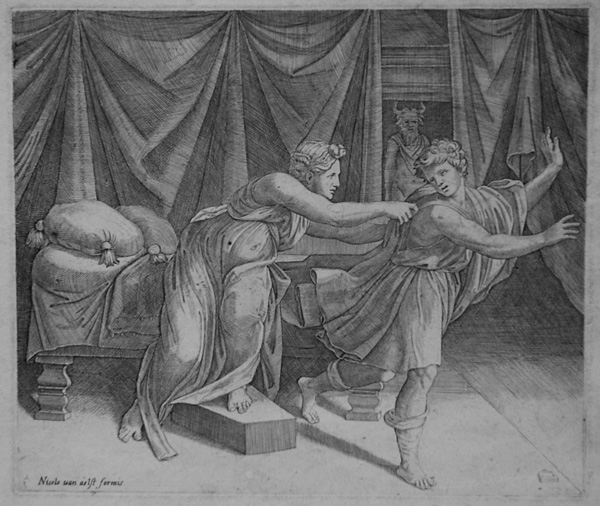 |
|
|
Marcantonio Raimondi (Venice c.1480-c.1529 Rome), Joseph and Potiphar's Wife (Bartsch 9, TIB 9 ). Engraving after Raphael's painting in the Vatican Loggia, c. 1518-1519. A good impression on laid paper with wide margins; the black mark in Potiphar's wife's stomach area and that on her right thigh are also to be found on the impression offered in Child's Gallery 2006 flyer at Please call or email for current pricing information. Inscribed: "Nicolo uan aelst formis" lower left with Marcantonio's empty tablet lower right. The state illustrated in Bartsch deos not indicate a publisher, so ours is a later impression. At some point, the plate was acquired by Nicola van Aelst, who died in 1613, so our impression was printed sometime between the 1570s and 1613. Image size: 205x244mm. Price: Please call or email for current pricing information.
|
|
|
|
|
After following the story of Judah and his daughter-in-law Tamar in chapter 38, in which Judah shows himslef as something less than a good, God-fearing person, we return to the story of Joseph in Genesis 39:1-12): "And Joseph was brought down to Egypt; and Potiphar, an officer of Pharaoh, captain of the guard, an Egyptian, bought him of the hands of the Ishmeelites, which had brought him down thither. And the LORD was with Joseph, and he was a prosperous man; and he was in the house of his master the Egyptian. And his master saw that the LORD was with him, and that the LORD made all that he did to prosper in his hand. And Joseph found grace in his sight, and he served him: and he made him overseer over his house, and all that he had he put into his hand. And it came to pass from the time that he had made him overseer in his house, and over all that he had, that the LORD blessed the Egyptian’s house for Joseph’s sake; and the blessing of the LORD was upon all that he had in the house, and in the field. And he left all that he had in Joseph’s hand; and he knew not aught he had, save the bread which he did eat. And Joseph was a goodly person, and wellfavoured. And it came to pass after these things, that his master’s wife cast her eyes upon Joseph; and she said, 'Lie with me.' But he refused, and said unto his master’s wife, 'Behold, my master wotteth not what is with me in the house, and he hath committed all that he hath to my hand; There is none greater in this house than I; neither hath he kept back any thing from me but thee, because thou art his wife: how then can I do this great wickedness, and sin against God?' And it came to pass, as she spake to Joseph day by day, that he hearkened not unto her, to lie by her, or to be with her. And it came to pass about this time, that Joseph went into the house to do his business; and there was none of the men of the house there within. And she caught him by his garment, saying, 'Lie with me': and he left his garment in her hand, and fled, and got him out." Joseph's righteousness contrasts with Judah's slipperiness both in refusing to follow the law by allowing his daughter-in-law to marry his younger son after her husband dies and his second son, Onan, is struck down by God for refusing to beget a son for his brother's widow and in his own willingness to "come into" Tamar when he thinks she is a prostiutute and to condemn Tamar to death when she becomes pregnant, a condemnation annulled when she shows him the ring that he gave her as a token of his debt to her when she was veiled. Rather than himself being stoned, he decides to truly pay his debt and allow her to marry his last son. His debt to Joseph, however, is still hanging over his head at the end of Genesis 38.
|
|
|
|
|
|
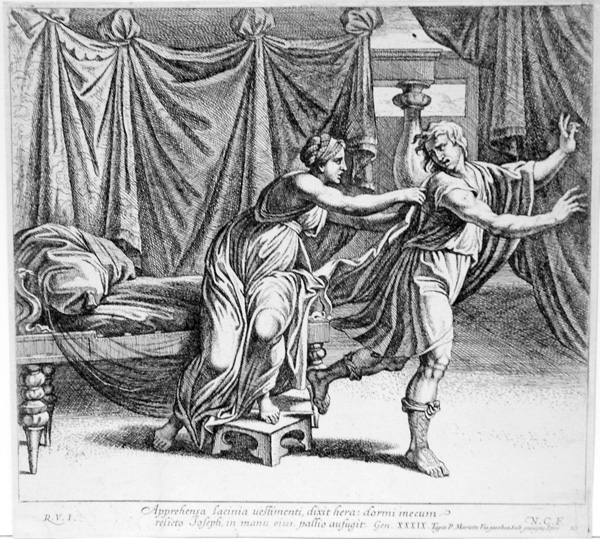 |
|
|
Nicolas Chapron (Chateaudun, France 1612-1656 Rome), Joseph and Potiphar's Wife. Engraving after Raphael's design for the Vatican Loggia executed by Giulio Romano. Inscribed "R.V.I." (Rapheal Urbino Invented it) lower left and "N.C.F." (Nicolas Chabron made it) lower right. First publihed by Chabron in Rome in 1649; our impression printed on laid paper with the adddress of the famous print publisher and collector Pierre Mariette (French, 1694-1774). Image size: 240x258mm. Price: Please call or email for current pricing information.
|
|
|
|
|
Returning to Joseph after his brother's story in the preceding chapter establishes that enough years have passed for Judah to have fallen in love, married, and beget three sons, we find that Joseph has prospered over the years: "And Joseph was brought down to Egypt; and Potiphar, an officer of Pharaoh, captain of the guard, an Egyptian, bought him of the hands of the Ishmeelites, which had brought him down thither. And the LORD was with Joseph, and he was a prosperous man; and he was in the house of his master the Egyptian. And his master saw that the LORD was with him, and that the LORD made all that he did to prosper in his hand. And Joseph found grace in his sight, and he served him: and he made him overseer over his house, and all that he had he put into his hand. And it came to pass from the time that he had made him overseer in his house, and over all that he had, that the LORD blessed the Egyptian’s house for Joseph’s sake; and the blessing of the LORD was upon all that he had in the house, and in the field. And he left all that he had in Joseph’s hand; and he knew not aught he had, save the bread which he did eat. And Joseph was a goodly person, and wellfavoured. And it came to pass after these things, that his master’s wife cast her eyes upon Joseph; and she said, 'Lie with me.' But he refused, and said unto his master’s wife, 'Behold, my master wotteth not what is with me in the house, and he hath committed all that he hath to my hand; There is none greater in this house than I; neither hath he kept back any thing from me but thee, because thou art his wife: how then can I do this great wickedness, and sin against God?' And it came to pass, as she spake to Joseph day by day, that he hearkened not unto her, to lie by her, or to be with her. And it came to pass about this time, that Joseph went into the house to do his business; and there was none of the men of the house there within. And she caught him by his garment, saying, 'Lie with me': and he left his garment in her hand, and fled, and got him out. " (Genesis 39:1-12).
|
|
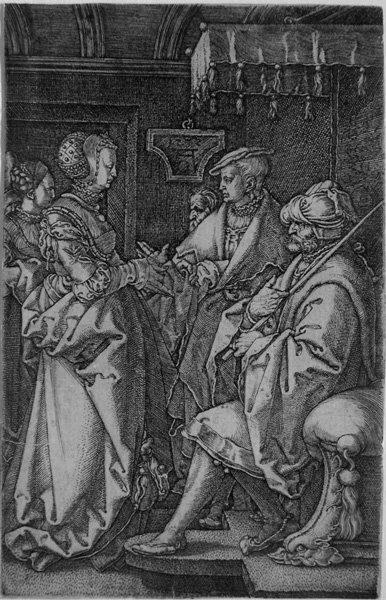 |
|
|
|
Heinrich Aldegrever (German, 1502-1555). Joseph accused by Potiphar's Wife (B. 20, New Hollstein 20 ii/ii). Original engraving, 1532. signed and dated in the plate on a tablet center top. A rich impression on laid paper. Trimmed on or within platemark. Provenance: unknown collector's stamp (VC) Lugt 2506 verso. Image size: 120x77mm. Price: Please call or email for current pricing information.
|
|
|
|
|
|
The basic theme of Joseph's life is has been established: "the LORD was with him, and that the LORD made all that he did to prosper in his hand," and we will need to remember that immediately: "And it came to pass, when she saw that he had left his garment in her hand, and was fled forth, That she called unto the men of her house, and spake unto them, saying, 'See, he hath brought in an Hebrew unto us to mock us; he came in unto me to lie with me, and I cried with a loud voice: And it came to pass, when he heard that I lifted up my voice and cried, that he left his garment with me, and fled, and got him out.' And she laid up his garment by her, until his lord came home. And she spake unto him according to these words, saying, The Hebrew servant, which thou hast brought unto us, came in unto me to mock me: And it came to pass, as I lifted up my voice and cried, that he left his garment with me, and fled out. And it came to pass, when his master heard the words of his wife, which she spake unto him, saying, 'After this manner did thy servant to me'; that his wrath was kindled. And Joseph’s master took him, and put him into the prison, a place where the king’s prisoners were bound: and he was there in the prison. But the LORD was with Joseph, and showed him mercy, and gave him favour in the sight of the keeper of the prison. And the keeper of the prison committed to Joseph’s hand all the prisoners that were in the prison; and whatsoever they did there, he was the doer of it. The keeper of the prison looked not to any thing that was under his hand; because the LORD was with him, and that which he did, the LORD made it to prosper" (Genesis 39:13-23). As the story continues, Joseph rises to be the Vizier of Egypt, the only nation not starving during the famine that follows the drought that ends the fat years and ushers in the lean years (where is our Joseph today?), in that role, he has a chance to deal again with his brothers when they come seeking grain to take back to their lands. When he tests them and find them no longer envious and murderous, he reveal shimself to them and explains the meaning of the story: " I am Joseph your brother, whom ye sold into Egypt. Now therefore be not grieved, nor angry with yourselves, that ye sold me hither: for God did send me before you to preserve life" (Genesis 45:4-5). The lesson of the story, then is that life is not random and that happy endings are possible, a lesson that the Hebrews will have need of remembering when a later Pharoah makes them all slaves and God calls Moses to deliver them. But that's another story (coming soon at your local website . . . ).
|
|
Spaightwood Galleries, Inc.
To purchase, call us at 1-800-809-3343 (1-508-529-2511 in Upton MA & vicinity) or send an email to spaightwood@gmail.com.
We accept AmericanExpress, DiscoverCard, MasterCard, and Visa.
We also accept wire transfers and paypal.
For directions and visiting information, please call. We are, of course, always available over the web and by telephone (see above for contact information). Click the following for links to past shows and artists. For a visual tour of the gallery, please click here. For information about Andy Weiner and Sonja Hansard-Weiner, please click here. For a list of special offers currently available, see Specials.
All works are sold with an unconditional guarantee of authenticity (as described in our website listing).
Copyright 2004-2017, Spaightwood Galleries, Inc.
Go back to the top of this page.
Visiting hours: Saturday 10:00 am to 5:00 pm and Sunday noon to 6:00 pm and other times by arrangement.
Please call to confirm your visit. Browsers and guests are welcome.
|
|
|
|
|
|
|
|
|
|
|
|
|
|
|
|
|
|
|
|
|
|
|
|
|
|
|
|
|
|
|
|
|
|
|
|
|
|




